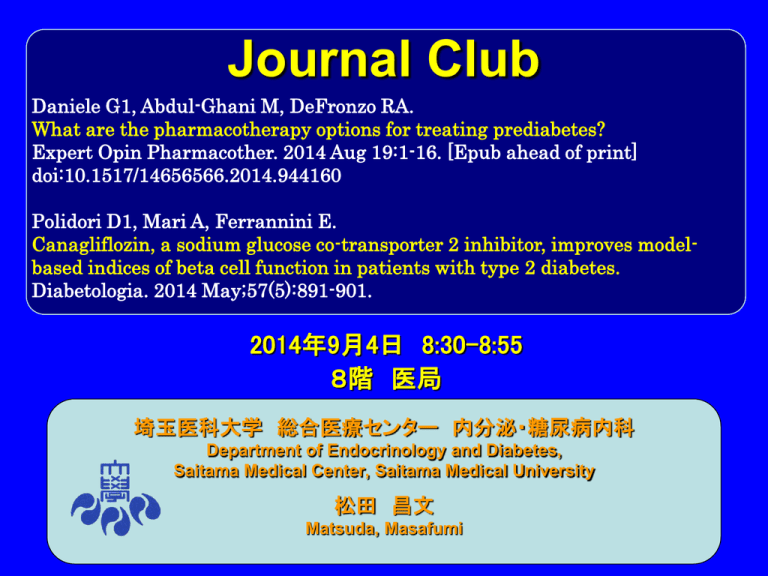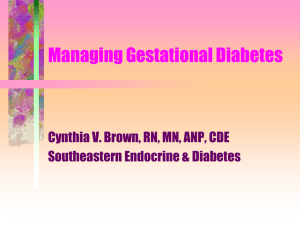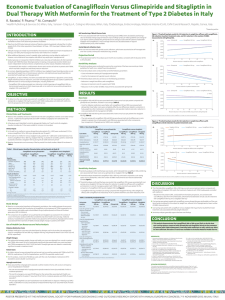
Journal Club
Daniele G1, Abdul-Ghani M, DeFronzo RA.
What are the pharmacotherapy options for treating prediabetes?
Expert Opin Pharmacother. 2014 Aug 19:1-16. [Epub ahead of print]
doi:10.1517/14656566.2014.944160
Polidori D1, Mari A, Ferrannini E.
Canagliflozin, a sodium glucose co-transporter 2 inhibitor, improves modelbased indices of beta cell function in patients with type 2 diabetes.
Diabetologia. 2014 May;57(5):891-901.
2014年9月4日 8:30-8:55
8階 医局
埼玉医科大学 総合医療センター 内分泌・糖尿病内科
Department of Endocrinology and Diabetes,
Saitama Medical Center, Saitama Medical University
松田 昌文
Matsuda, Masafumi
糖尿病発症予防介入試験
Trial
publication
follow-up,
year
No. of new
No.(total)
on-set of DM
drug
event
per 1000
person-years
control
37
21
16
391
397
393
105.1
58.8
45.2
37
122
121.3
No. of new
No.(total)
on-set of DM
event
per 1000
person-years
Thiazolidine
*DPP
2005
0.9
Troglitazone
10
387
28.7
Placebo
Metformin
ILS
TRIPOD
2002
2.5
Troglitazone
17
114
59.6
Placebo
PIPOD
2006
3.0
Pioglitazone
11
86
42.6
-
*DREAM
2006
3.0
Rosiglitazone
306
2365
43.1
Placebo
686
2634
86.8
*ACTNOW
2008
4.0
Pioglitazone
10
303
8.3
Placebo
45
299
37.6
*CANOE
2010
3.9
Met+Rosi
14
103
34.9
Placebo
41
104
101.1
Other (α-GI, statin, fibrate, glinide)
WOSCOP
2001
5.0
Pravastation
57
2999
3.8
Placebo
82
3975
5.5
*STOP- NIDDM
2002
3.3
Acarbose
221
682
98.2
Placebo
285
686
125.9
BIP
2004
6.2
Bezafibrate
66
156
68.2
Placebo
80
147
87.8
*VICTORY
2009
4.0
Voglibose
50
897
13.9
Placebo
106
881
30.0
*NAVIGATOR
2010
6.5
Nateglinide
1674
3726
69.1
Placebo
1580
3747
64.9
*:エンドポイントとして設定あり
Matsuda M.;GEKKAN TOUNYOUBYOU;2,16-22,2010 2:16-22, 2010.
Original Article
Weight Loss with a Low-Carbohydrate,
Mediterranean, or Low-Fat Diet
Israel, Germany, Boston
Iris Shai, R.D., Ph.D., Dan Schwarzfuchs, M.D., Yaakov Henkin, M.D., Danit R. Shahar, R.D., Ph.D., Shula
Witkow, R.D., M.P.H., Ilana Greenberg, R.D., M.P.H., Rachel Golan, R.D., M.P.H., Drora Fraser, Ph.D., Arkady
Bolotin, Ph.D., Hilel Vardi, M.Sc., Osnat Tangi-Rozental, B.A., Rachel Zuk-Ramot, R.N., Benjamin Sarusi,
M.Sc., Dov Brickner, M.D., Ziva Schwartz, M.D., Einat Sheiner, M.D., Rachel Marko, M.Sc., Esther Katorza,
M.Sc., Joachim Thiery, M.D., Georg Martin Fiedler, M.D., Matthias Blüher, M.D., Michael Stumvoll, M.D., Meir
J. Stampfer, M.D., Dr.P.H., for the Dietary Intervention Randomized Controlled Trial (DIRECT) Group
In this 2-year trial, we randomly
assigned 322 moderately obese
subjects (mean age, 52 years;
mean body-mass index [the
weight in kilograms divided by the
square of the height in meters],
31; male sex, 86%) to one of three
diets: low-fat, restricted-calorie;
Mediterranean, restricted-calorie;
or low-carbohydrate, non–
restricted-calorie.
Shai I et al. N Engl J Med 2008;359:229-241
Weight Changes during 2 Years According to Diet Group
Shai I et al. N Engl J Med 2008;359:229-241
TZD投与により長期の良好な血糖コントロールが可能
-多数例での直接比較成績-
SU薬群のHbA1cの変化
(%)
1
TZD群のHbA1cの変化
(%)
1
(n=1,441)
(n=1,573)
ベ
ー
ス 0
ラ
イ
ン
か
ら
の -1
変
化
ベ
ー
ス 0
ラ
イ
ン
か
ら
の -1
変
化
(n=230)
(n=48)
(n=181)
(n=39)
(n=272)
(n=313)
(n=250)
(n=297)
(n=232)
(n=301)
(n=1,456)
(n=178)
(n=115)
(n=317)
(n=250)
(n=249)
-2
0
1
2
3
4
5
6
-2
10(年)
0
1
2
3
4
5
6 (年)
CHICAGO
アクトス vs.グリメピリド
PERISCOPE
アクトス vs.グリメピリド
Tan
Hanefeld
アクトス vs.グリブライド
ADOPT
ロシグリタゾン vs.グリブライド
RECORD ロシグリタゾン vs.SU薬
Rosenstock ロシグリタゾン
Charbonnel
グリクラジド
Alvarsson グリブライド
Alvarsson
UKPDS
グリブライド
SU薬
アクトス vs. グリクラジド
DeFronzo.A.R. et al: American Journal of Medicine, 123, S38, 2010
DPP-4阻害薬のHbA1cの変化
Ahrén B, et al; for the HARMONY 3 Study Group.: HARMONY 3: 104-Week Randomized, Double-Blind, Placebo- and ActiveControlled Trial Assessing the Efficacy and Safety of Albiglutide Compared With Placebo, Sitagliptin, and Glimepiride in
Patients With Type 2 Diabetes Taking Metformin. Diabetes Care. 2014 Jun 4. pii: DC_140024.
血糖安定化はSitagliptinより強力!
Diabetes Care. 2013 Sep;36(9):2508-15. (reviewed on 2013/7/11)
Pioglitazone と Dapagliflozinの併用
Placebo (pilglitazone alone)
dapagliflozin 5mg
dapagliflozin10mg
Changes in glycemic parameters for placebo (circles), dapagliflozin 5 mg (squares), and
dapagliflozin 10 mg (triangles) all plus pioglitazone ≥30 mg
LEFT: Mean change from baseline in HbA1c after adjustment for baseline value over time
RIGHT: Mean change from baseline in total body weight after adjustment for baseline value over
time Includes patients who took at least one dose of double-blind study medication
Error bars represent 95% CIs Treatment symbols shifted horizontally to prevent error bars from
overlapping
Diabetes Care 35:1473–1478, 2012
pioglitazonとalogliptinの併用効果
インスリン分泌の改善!
European Journal of Endocrinology 170:565–574, 2014
Expert Opin Pharmacother. 2014 Aug 19:1-16. [Epub ahead of print]
doi:10.1517/14656566.2014.944160
Introduction:
The incidence of type 2 diabetes mellitus (T2DM)
has risen to epidemic proportions, and this is
associatedwith enormous cost. T2DM is
preceded by ‘prediabetes’, and the diagnosis of
impaired glucose tolerance (IGT) and/or impaired
fasting glucose (IFG) provides an opportunity for
targeted intervention. Prediabetic subjects
manifest both core defects characteristic of T2DM,
that is, insulin resistance and b-cell dysfunction.
Interventions which improve insulin sensitivity
and/or preserve b-cell function are logical
strategies to delay the conversion of IGT/IFG to
T2DM or revert glucose tolerance to normal.
Areas covered:
The authors examine pharmacologic agents that
have proven to decrease the conversion of IGT to
T2DM and represent potential treatment options
in prediabetes.
Figure 1. Insulin sensitivity (box plot of M/I) in individuals with NGT, impaired fasting
glucose (IFG), impaired glucose tolerance (IGT) and type 2 diabetes mellitus (T2DM).
Reproduced from [150].
*Indicate a significant difference from the NGT group. NGT: Normal glucose tolerance.
Figure 2. Insulin secretion/insulin resistance (disposition) index (defined as increment in insulin/increment in
glucose ÷ insulin resistance [DINS/DGLU ÷ IR]) in individuals with normal glucose tolerance (NGT), impaired
glucose tolerance (IGT) and type 2 diabetes mellitus (T2DM) as a function of the 2-h plasma glucose (PG)
concentration in lean (closed circles) and obese (open circles) subjects.
Material from this publication has been used with the permission of American Diabetes Association. American Diabetes Association (2009). Copyright and all rights reserved [15].
Figure 3. Change in body weight during the DPP, during the overlap period, and during
the DPP Outcomes Study (DPPOS).
Reprinted by permission from Macmillan Publishers Ltd. Copyright and all rights reserved [151].
DPP: Diabetes prevention program.
Figure 4. Relationship between weight loss and type 2 diabetes incidence at study
end in the cohort of subjects with prediabetes and/or metabolic syndrome.
Error bars represent 95% CI. Annualized incidence rate of type 2 diabetes was based on first
occurrence of two consecutive fasting glucose values ‡ 7.0 mmol/l, two consecutive 2-h plasma
glucose values during OGTT ‡ 11.1 mmol/l or taking antidiabetic medications at end point.
Material from this publication has been used with the permission of American Diabetes Association. American Diabetes Association
(2013). Copyright and all rights reserved [87]. *p < 0.05 versus < 5% weight loss for all comparisons. T2DM: Type 2 diabetes mellitus.
Figure 5. Relationship between the annual diabetes incidence rate and the change in the
ln of insulin secretion (IS)/insulin resistance (IR) index in the combined pioglitazone- and
placebo-treated individuals.
Material from this publication has been used with the permission of American Diabetes Association. American Diabetes Association (2013). Copyright and all rights reserved [110].
Figure 6. Effect of physiologic (left) and pharmacologic (right)
doses of GLP-1 on insulin secretion in NGT individuals and in
subjects with T2DM.
Reproduced from [62].
GLP-1: Glucagon-like peptide-1; NGT: Normal glucose tolerance; T2DM: Type 2 diabetes mellitus.
Expert opinion:
Weight loss improves whole body insulin sensitivity,
preserves b-cell function and decreases progression of
prediabetes to T2DM. In real life long-term weight loss is the
exception and, even if successful, 40 -- 50% of IGT
individuals still progress to T2DM. Pharmacotherapy
provides an alternative strategy to improve insulin sensitivity
and preserve b-cell function. Thiazolidinediones (TZDs) are
highly effective in T2DM prevention. Long-acting glucagonlike peptide-1 (GLP-1) analogs, because they augment b-cell
function and promote weight loss, are effective in preventing
IGT progression to T2DM. Metformin is considerably less
effective than TZDs or GLP-1 analogs.
Message
メトホルミンがよいようによく言われるが、実
際のところIGTの薬物介入をするとしたらインス
リン抵抗性改善薬でもTZDとGLP-1受容体作動薬
が有用!
しかし、Metforminの評価はこのレビューでは低
いし、実際にも同様に感じる。
SGLT-2阻害薬は引用で1つ文献があるが、今後
の課題である。これもとても有効!
選択的SGLT2阻害剤
フロリジン
国内で承認済又は開発中の主なSGLT2阻害剤(2014年8月現在)
トホグリフロジン
HO
HO
Et
O
O
OH
カナグリフロジン
Me
HO
OH
HO
O
OH
S
OH
F
エンパグリフロジン
Me
HO
HO
O
OH
OH
O
O
ダパグリフロジン
CI
HO
HO
OEt
イプラグリフロジン
O
OH
OH
ルセオグリフロジン
MeO
F
O
HO
S
OH
HO
OH
HO
Me
OEt
S
OH
HO
OH
Liu JJ et al.:Diabetes 61(9):2199,2012より改変
New Current 24(15):2,2013より改変
SGLT-2阻害薬の効果
HbA1c(%)
8.0
FPG(mg/dL)
FPG(mg/dL)
160
HbA1c(%)
150
7.5
140
7.0
6.5
130
6.0
120
5.5
110
5.0
100
mg
205.5
308.3
205.5
411.0
205.5
308.3
205.5
205.5 円/日
添付文書のデータについてHbA1cが8%で開始し、Placebo使用でFPG/HbA1cが20のままとし補正。
(1)Janssen Research & Development, LLC, 3210 Merryfield Row, San Diego, CA 92121,
USA
(2)Institute of Biomedical Engineering, National Research Council, Padua, Italy
(3)Department of Clinical and Experimental Medicine, University of Pisa School of
Medicine, Pisa, Italy
Aims/Hypothesis:
In rodent models of diabetes, treatment with
sodium glucose co-transporter 2 (SGLT2)
inhibitors improves beta cell function. This
analysis assessed the effects of the SGLT2
inhibitor, canagliflozin, on model-based
measures of beta cell function in patients
with type 2 diabetes.
Methods:
Data from three Phase 3 studies were analysed, in
which: (Study 1) canagliflozin 100 and 300 mg were
compared with placebo as monotherapy for 26
weeks; (Study 2) canagliflozin 100 and 300 mg were
compared with placebo as add-on to
metformin + sulfonylurea for 26 weeks; or (Study 3)
canagliflozin 300 mg was compared with sitagliptin
100 mg as add-on to metformin + sulfonylurea for 52
weeks. In each study, a subset of patients was given
mixed-meal tolerance tests at baseline and study
endpoint, and model-based beta cell function
parameters were calculated from plasma glucose
and C-peptide.
placebo
canagliflozin 100 mg
canagliflozin 300 mg
Fig. 2 (a–c) Plasma glucose, (d–f) C-peptide and (g–i) insulin concentrations, and
(j–l) ISR per plasma glucose values in Study 1. Black circles, baseline; white
circles, Week 26. Values are mean ± SEM for placebo (a, d, g, j), canagliflozin
100 mg (b, e, h, k) and canagliflozin 300 mg (c, f, i, l)
placebo
canagliflozin 100 mg
canagliflozin 300 mg
Fig. 3 (a–c) Plasma glucose, (d–f) C-peptide and (g–i) insulin concentrations, and
(j–l) ISR per plasma glucose values in Study 2. Black circles, baseline; white
circles, Week 26. Values are mean ± SEM for placebo (a, d, g, j), canagliflozin
100 mg (b, e, h, k) and canagliflozin 300 mg (c, f, i, l)
sitagliptin 100 mg
canagliflozin 300 mg
Fig. 4 (a, b) Plasma glucose, (c, d)
C-peptide and (e, f) insulin
concentrations, and (g, h) ISR per
plasma glucose in Study 3. Black
circles, baseline; white circles,
Week 52. Values are mean ± SEM
for sitagliptin 100 mg (a, c, e, g) and
canagliflozin 300 mg (b, d, f, h)
Data are mean (SD) unless
otherwise indicated
aIn pmol min−1 m−2 at
9 mmol/l glucose
bWeek 26 for Studies 1 and
2; Week 52 for Study 3
cΔLSM is the PBOsubtracted LSM change
from baseline for Studies 1
and 2 and the LSM change
from baseline for Study 3.
For glucose sensitivity,
ΔLSM values are reported
for the untransformed
variables, but statistical
testing was performed on
log-transformed values
d p values vs PBO for
Studies 1 and 2, and vs SITA
for Study 3
eIn pmol min−1 m−2
(mmol/l)−1
fIn pmol m−2 (mmol/l)−1
gΔMean is the mean change
from baseline
hIn pmol/m2
iIn ml min−1 m−2; not
corrected for UGE
jIn ml min−1 m−2
kThe number of patients
with OGIS values is smaller
than the number of patients
with the other measures, as
some patients had
insufficient insulin and/or
UGE measurements to
perform the OGIS
calculations
CANA 100, canagliflozin
100 mg; CANA 300,
canagliflozin 300 mg; GS,
glucose sensitivity; PBO,
placebo; SITA 100,
sitagliptin 100 mg
Results:
In Studies 1 and 2, both canagliflozin doses increased
beta cell glucose sensitivity compared with placebo.
Placebo-subtracted least squares mean (LSM) (SEM)
changes were 23 (9) and 18 (9) pmol min−1
m−2(mmol/l)−1 with canagliflozin 100 and 300 mg,
respectively (p < 0.002, Study 1), and 16 (8) and 10 (9)
pmol min−1 m−2(mmol/l)−1 (p < 0.02, Study 2). In Study 3,
beta cell glucose sensitivity was minimally affected, but
the insulin secretion rate at 9 mmol/l glucose increased
to similar degrees from baseline with canagliflozin and
sitagliptin [LSM (SEM) changes 38 (8) and 28 (9) pmol
min−1 m−2, respectively; p < 0.05 for both].
Conclusions/interpretation:
Treatment with canagliflozin for 6 to 12
months improved model-based measures of
beta cell function in three separate Phase 3
studies.
Trial registration: Clinicaltrials.gov NCT01081834 (Study 1);
NCT01106625 (Study 2); NCT01137812 (Study 3)
Message
SGLT-2阻害薬の膵β細胞保護作用は非常にすぐ
れている。Sitagliptinよりも膵β細胞保護作用
が強い!
インスリン分泌能をみるのに、このような負荷
試験と数値解析が今後も増えてゆくと思われ
る。
インスリン感受性の方はちょっと難しいところ
がある。










